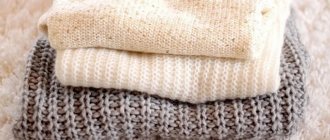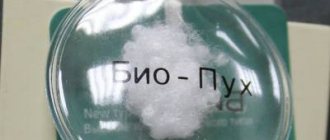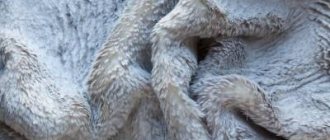Home page » Home and comfort » Washing
Author of the article
Svetlana Pavlikhina
Reading time: 4 minutes
AA
Silk consists of thin fibers, which contain proteins and amino acids that have a positive effect on the condition of the human body. Bedding made from this material is weightless and pleasant to the touch. But in order for the blanket to retain its qualities, it must be properly cared for.
You need to know how to wash such products and whether this procedure can be performed in an automatic machine.
Caring for a silk blanket, what you need to know
As you know, silk products are very durable, and with proper care of silk blankets, their service life increases to 20 years. What does it consist of?
Silk blankets are not machine washable and do not require frequent cleaning. If it seems to you that the silk blanket has become heavier or has become less warm, then it needs to be dried. Drying such a product is not difficult at all. The blanket does not even need to be removed from the duvet cover, it is simply left in the sun, under which the silk heats up, evaporates the accumulated moisture and becomes warm, light and elastic again.
If you dry a blanket without a duvet cover, then you need to try to prevent the sun's rays from falling on the blanket. Silk products should be stored in a dry, ventilated area. It is not recommended to use vacuum packaging when storing it: silk must breathe. Those who believe that it is impossible to spoil a silk blanket during storage are mistaken; it is enough to put heavy things on it to be convinced of this. Just as down comforters need to be fluffed occasionally to give them their initial airiness, duvets with silk filling need periodic tapping.
Proper care of a silk blanket has another important feature. So, when using silk blankets, you must put a duvet cover on them. The most optimal material for a duvet cover is silk; it will not allow skin oils and sweat to be transferred from a person to the duvet and back, and it will protect the duvet from dust and dirt. With such a duvet cover, the period of time between cleaning the duvet can be significantly increased.
But it is best to take your silk blanket to the dry cleaner
In order not to spoil a silk blanket, it is better to dry clean the product. Just before doing this, you should make sure that the company you have chosen has an idea of how to properly care for a silk blanket. You should also be careful with dry cleaning because the chemicals used can make the silk hard and rough.
If there are stains of sebum on the silk blanket, you can either carefully wash them by hand or wipe them with alcohol. If the blanket needs ironing, it is better to use steam ironing. Do not forget that silk is a very soft and delicate material, so you should not lie or even sit on it for a long time, it can become wrinkled. In this way, silk is very similar to fluff, and in order for it to return to its original shape, it is enough to shake it well.
In order for a silk blanket to retain its original properties for as long as possible, it needs appropriate care. So, silk blankets should not be washed; it is better to take them to a dry cleaner, where professionals in this matter will take care of your purchase, without a doubt, better than you. The only thing you have to do is periodically dry the blankets to restore their softness, elasticity and lightness. To prevent it from becoming wrinkled, you need to shake it occasionally, returning it to its former airiness.
odeialo.ru
Pros and cons of a silk quilt
Cons of a silk blanket
- High price : after all, silk production is a labor-intensive and painstaking process, hence the price.
- Difficult to care for : silk is very delicate. To remove stains from silk, it is best to send it to the dry cleaner. Additionally, frequent cleaning can reduce the lifespan of silk.
Pros of a silk blanket
- Lightness : A silk duvet is incredibly light, making it feel like you're sleeping in the clouds. Plus, silk can keep you cool in summer and warm in winter.
- Breathable : A silk blanket is great for those who sweat a lot while sleeping. And in general, due to the fact that the blanket allows air to pass through well, it cannot be too hot under it.
- Suitable for allergy sufferers and asthmatics : silk contains natural proteins and amino acids that can repel dust mites, mold and mildew.
- Long service life : High quality silk can serve you for a very long time.
Overall, as one of nature's wonderful materials, silk is soft and smooth , and is also the strongest natural fiber in the world . Just a minute)!
Features of a silk blanket and its care
Firstly, silk does not absorb dust, so dust mites do not take root inside such blankets. This means that a silk blanket can be washed much less often than any other, since it does not require treatment against parasites.
Secondly, modern washing machines significantly simplify the care of delicate and expensive items. With such an assistant, you don’t need to worry about how to wash a blanket with silk filling - just select the delicate wash mode (water temperature no higher than 30°C) and liquid detergent. For those who do not know how to wash a Chinese silk blanket, the advice of Chinese manufacturers will be useful: use shampoo or shower gel instead of powder.
If only a couple of spots appear on a silk blanket, you can gently wipe them with alcohol or a mixture of water and ammonia (2:1), and then rinse the product in clean water. You need to wring out the blanket at low drum speeds, and dry it in the shade, avoiding direct sunlight.
Don't forget to throw balls into the washing machine (you can use tennis balls). The balls bounce around in the drum and knock dirt out of the blanket, and also break it up so that the filling does not crumple.
There is another effective way to do laundry - in the bathroom. You pour water into the bathtub, add detergent, put a blanket in there and trample it with your feet.
comfortvdom.ru
What properties does a silkworm blanket have?
Of course, the best option is if you have a silk blanket with 100% silk - regardless of whether the silk is wild or farmed. You can always check the composition of a silk blanket on the label. But even if the composition contains some other filler, the higher the percentage of silk, the better.
A silk blanket has a number of good properties. In particular, Mulberry silk is very thin, so the weight of the blanket is very light . This blanket is especially suitable for summer because you can't overheat under it.
Mulberry silk and Tussa silk are highly insulating. retains your own body heat very well , so it is perfect for winter.
At the same time, silk has antibacterial properties. This means that dust mites will not grow in a silk duvet, so silk is also suitable for people with allergies. And also for children and babies.
Features of cleaning blankets
There are not so many ways to freshen a blanket, but there are plenty of washing nuances. And all because the different materials from which the bedspread is made require compliance with certain cleaning conditions. A common feature of care is that you should not wash products too often, only when necessary.
Subtleties of caring for blankets made of different materials - table
Preparatory stage
Regardless of the type of washing - hand or machine - for effective cleaning, the blanket must be properly prepared.
- We treat minor small stains with special means (sprays, foams and pencils). When using them, you must carefully read the instructions.
- We check the integrity of the cover and the edging tape, otherwise the fibers will get into the drum of the washing machine and ruin it.
- To ensure that the detergent rinses well, and also to avoid streaks after washing, we use liquid powders.
- Before putting it in the machine, we roll the product so that during the washing process it is evenly distributed in the drum.
- If machine washing is possible, then the cycle should be delicate, otherwise the filler will form clumps.
Subtleties of machine wash
Hand washing is not the exclusive approach to caring for your blanket. The product label always indicates the features of this type of processing. But if the factory instructions are lost, you should pay attention to the following parameters:
- the weight of the product (if it is greater than the loading capacity of the machine or the same, then hand washing remains);
- size (before rinsing a large blanket, you need to drain the water from the drum: this will make the weight of the product a little less, which means it will rinse better);
- texture (if the filler can be removed, then this should definitely be done, and the cover should be washed in accordance with the recommendations for the type of fabric from which it is made).
The nuances of hand washing
This type of washing is a relatively safe option for preserving the basic qualities of the blanket. The treatment is carried out in a bath filled with water at a suitable temperature. If there are stains, they are treated first, and only then the blanket is washed completely. The product should be straightened as much as possible. If spinning is permissible, for example, when washing a patchwork product, then it would be a good idea to call an assistant for this purpose, since the weight of a wet blanket will be considerable. Before drying, the blanket should be allowed to drain by laying it out on a horizontal surface.
Buying a silk blanket
Do you have a desire to buy a silk blanket? If you start buying, be curious about blankets and see what fillings they can offer you. Silk filler comes in several varieties, which differ in their properties and qualities, and, therefore, there are differences in care. Low-quality silk filling clumps and is unevenly distributed inside the blanket. What causes the blanket to lose its shape. This filler prevents washing, since water and the drum of the washing machine will turn it into a rag. To avoid such problems, learn not to skimp on your health, save your nerves and buy a blanket that is more expensive, but of better quality.
The quality of silk thread depends on the type and technology of silkworm care. Northern (wild) silkworm - Tussa, which produces threads that are inferior in quality to another species - the cultivated Mulberry. Mulberry mulberry has remarkable properties, is good for health and has a large margin of safety. This silk combines strength, elasticity and at the same time pleasant and gentle to the touch, is not difficult to care for and is several times stronger than other varieties.
Modern technologies have not bypassed silk production. The result is a more refined Mulberry silk. The intricacies of ancient methods of producing silk and modern know-how in the field of sericulture became the beginning of a new brand - Silkwash. Its characteristics are amazing - wear-resistant, stain-resistant, a natural barrier to microorganisms.
Caring for products made from different materials
Find out what the blanket is made of, assess the extent of the contamination, and only then choose the appropriate method to return the product to purity and freshness.
New blankets may not smell very nice after purchase. But it is recommended not to wash them, but to dry them in the sun or hang them out in the cold.
Washing and steam cleaning quilts and duvets
Large-scale washing carried out according to the rules is acceptable for down and cotton products. First of all, assess the situation: you may not need to wash it, but it will be enough to just remove the stains and dry the blanket well in the fresh air. If weather permits, do this in midday UV light, but be sure to cover the blanket with a thin cotton cloth to protect against fading.
Sunbathing is also recommended before washing a blanket that has absorbed the smell of old things.
But if you cannot do without global cleaning, pay attention to the sequence of steps.
- We wash away the dirt or treat it with a stain remover (for example, Faberlic spray).
- We process it in an automatic machine or by hand at a water temperature of maximum 40 °C.
- For rinsing, add 5-7 tennis balls (you can do this during the washing process) so that the cotton wool does not crumple.
- Let it drain and lay it out on a horizontal surface to dry.
You can use steam to clean a cotton blanket. In addition to removing dirt, you will also get rid of unpleasant odors.
- Rub or spray stain remover over the entire surface of the product.
- Lightly wet the blanket with water and lay it out horizontally.
- We direct the iron in steam mode or a special steam generator at a right angle to the blanket and thoroughly clean it.
- Dry outdoors, preferably in the sun.
Wet cleaning and washing of wool and camel products
Experienced housewives claim that due to the vulnerability of natural fibers, it is better not to wash such products, but to wet clean them. This way you will get rid of dirt and unpleasant odors, and even disinfect it. But this procedure has nuances.
- Pour warm water (about 30 °C) into a bowl.
- Add washing gel.
- Using a soft brush, apply foam to a blanket laid out on a horizontal plane.
- Remove it with a cotton cloth moistened with clean water.
If this cleaning does not help with grease and stains, wash the blanket.
- Pour water (30 °C) into the bath and add washing gel.
- Lay out the blanket and leave for 1–1.5 hours.
- We raise and lower the canvas several times, if necessary, lightly rub the contaminated areas of the product.
- Roll up to remove soapy water.
- Rinse well, also lifting and lowering the product.
- We twist it again.
The unpleasant smell of sheepskin is not a reason to send the blanket to the wash. It can be removed using dry cleaning or a simple mixture of 1 tbsp. baking soda and 8-10 drops of a pleasant-smelling essential oil. Sprinkle the blanket with this mixture and wipe off the remains after a day. There will be no trace of amber: the soda will absorb the stench, and the oil will add a subtle aroma.
How to wash a sheep's wool blanket - video
Caring for silk blankets
This product is washed in two steps: cover and filler. The outer part is cleaned in accordance with the recommendations for processing the fabric from which it is made. But cleaning the fibers will not cause any particular difficulties.
- Soak the filler in warm soapy water.
- After 1-2 hours, rinse thoroughly.
- Dry in a horizontal plane.
Rules for washing flannelette, patchwork and bamboo products
Fleece is the most unpretentious material: you can clean it manually or in a machine, set the temperature to 30–40 °C. And you can even spin it automatically, although the number of revolutions should be minimal. But flannelette blankets dry well on a line. Patchwork will also not cause much trouble: it can be washed at 40 °C and dried on a horizontal surface.
The bamboo product can be washed at a temperature not exceeding 30 °C. After a minimum spin, dry flat. Bamboo blankets are resistant to bleach. If there is a need to remove stains, you can use laundry soap or a folk remedy suitable for a specific type of stain.
Subtleties of caring for blankets made of padding polyester, non-woven fabric and holofiber
Products made from synthetic fibers are washed at 40 °C and with a spin speed of 800 rpm. You should throw 6–8 tennis balls into the drum and rinse the product 1–2 additional times. Before drying, shake several times to give it the correct shape. To dry evenly, turn the blanket over several times.
An original way to wash a synthetic blanket - video
Rules for washing silk products
Washing silk products requires a special approach. First you need to find out what material the item is made from. If we are talking about artificial silk, then you can use white toilet or baby soap. If you need to wash natural silk, then you can use neutral powders and soaps.
To ensure that bed linen or a beautiful silk blouse retains its original properties and does not lose its commercial appearance, you must adhere to the following recommendations:
- before washing, silk items should be soaked in warm water, to which a few drops of colorless detergent are first added;
- the water temperature should not be higher than forty degrees;
- It is best to use boiled water;
- Silk should be rinsed with the addition of a softener and antistatic agent;
- You cannot wring out such fabric;
- It is also not recommended to wash certain areas, otherwise the fabric will be damaged.
When it comes to washing silk items, the most questions that arise are about the choice of water temperature. Usually the manufacturer indicates this information on the tag of clothing or bed linen. If such data is not available, then the temperature may be 40°C. However, if the material tends to shed, then the temperature should not exceed 30°C. The water should not be too hard. To soften it, you can add 10 g of soda per liter of liquid.
How to get rid of lumps
This problem most often occurs with cotton and down blankets. But there are several ways to solve it. Try a wash and rinse with tennis balls, which break up clumps as you clean.
Methods using a carpet cracker and a hairdryer
During the drying process, you can beat the filler with a carpet clapper every 3-4 hours, and then straighten out the lumps with your hands. This approach alone is rarely sufficient. Try using a hair dryer. A fan heater is also suitable instead.
- We lay out the well-dried product on a horizontal plane.
- We direct the air stream at the lumps.
- Use your fingers to help the filler distribute evenly.
How to remove clumps with a vacuum cleaner
- We put the well-dried blanket in a plastic bag.
- Using a vacuum cleaner, suck out the air from there.
- We make a hole in the packaging and use the blowing mode to help the filler to distribute evenly.
How to bleach?
There are three ways to bleach a silk product
- Using sea salt.
- By increasing the temperature.
- Using special means.
Let's look at each of them.
Sea salt
To whiten with sea salt you will need:
- sea salt;
- washing powder for silk fabric;
- ammonia;
- hydrogen peroxide.
You need to do the following:
- Wash and rinse the silk item as described above.
- Dilute 8 tablespoons of sea salt, 15 ml of ammonia and 30 ml of hydrogen peroxide in 10 liters of water.
- Place a silk product in the resulting solution and leave it for 5 hours, covering it with a lid.
- Remove the item and rinse it twice in cool water.
Temperature increase
To bleach by increasing the temperature, you will need laundry soap and bulky metal utensils. To carry out the procedure, you must perform the following steps:
- Dissolve 1 bar of laundry soap in 10 liters of water;
- place a silk item in the resulting solution;
- place the container with the product on the stove and heat to 90 degrees Celsius;
- cool the item slowly;
- After cooling, remove it and rinse twice in cold water.
This method can seriously damage the silk, so should only be used if there is a significant color change. For natural silk fabrics it is better not to use it at all.
Special means
The simplest, most affordable and safest way to whiten is to use special products that can be purchased at household chemical stores.
Usually you need to soak the item in their solution for a while or add them during washing. An example of such a product is the popular Vanish bleach.
How to clean a blanket without washing
You can deal with dirt using laundry soap or a mixture of 1 part washing powder, 1 part grated soap and 2 parts water.
- Apply the product to the stain.
- We treat the surface with a stiff brush.
- Use a soft sponge to remove excess moisture.
You can get rid of urine stains and unpleasant odors by evaporating the dirt with an iron. The method is suitable for blankets made of any material. You can also soak the stain with hydrogen peroxide or apple cider vinegar and then rinse off the residue with water. But this option is not suitable for coconut and silk fillers.
Wash by hand
Many people prefer to wash silk items only by hand. For this purpose it is better to take boiled water. At the same time, its temperature should not exceed 40 degrees. You should also prepare a solution from powder or soap, which should have thick foam. The detergent must be completely dissolved so that there is no sediment.
Washing silk by hand
Do not use products containing bleaches and additives that help cope with severe stains. It is best to use baby soap or gentle powders.
Silk items are soaked in the prepared solution for a short time. It will be enough to keep them there for 15 minutes. At the same time, they should not be thoroughly soaped, much less rubbed and stretched the fabric itself. Such products cannot be wrung out or twisted. You can straighten them with your hands and wait until all the excess water drains.
For washing bright and colored silk, it is best to use a solution based on potato starch. To prepare it, you need to boil the potatoes, drain the broth and place silk items in it. Then cover the container with a lid and leave the products in the starch solution for two hours.
After the required time has passed, things are removed from the liquid, and two large spoons of medical alcohol are added there. The items are placed back into the solution and can be gently washed.
ARTICLE FOR YOU
How to properly wash linen and flock items
To maintain the brightness of silk items, colored items should first be rinsed in warm water and then in cold water, after adding a spoonful of white vinegar. This technique gives its results, and things retain their rich shade for as long as possible.
Vinegar to preserve color
Prevention
If there is no trouble with the blanket in the form of random stains, there is no need to bother yourself with washing and cleaning. You can limit yourself to a few regular procedures, regardless of the material of the product.
- Ventilate in fresh air once or twice a year.
- Every winter, when it’s cold, take it out onto the balcony for 3–4 hours.
- Treat with a household steam generator two to three times a year. But only if the label does not prohibit such influence.
Washing a blanket at home is a labor-intensive task. If you find out all the features of washing a specific type of product, then in 1–3 days you will be able to return it to cleanliness. And if there are no incidents, then it is enough to carry out such a global cleaning once every one to one and a half years, since preventive measures for caring for a warm, cozy friend are quite enough.
advice.help
forum.ykt.ru
Can it be washed in a washing machine, at what temperature?
Depending on the production technique, there are 3 types of silk fabric:
- natural;
- artificial;
- synthetic.
To wash silk fabric of any of these varieties, you do not have to go to the dry cleaner. If you follow simple rules, anyone can do this at home.
Natural
Silk is made from fiber produced by the silkworm larva. It is very thin and sensitive, so it is easily destroyed during washing. However, you can still wash silk fabrics.
When washing, it is important to strictly observe the temperature regime (water should not be hotter than 30 degrees) and use auxiliary products that will help not damage the fabric.
Silk fabrics are washed only by hand. Machine washable. After the first session, the canvas loses its original shape due to deformation or rupture of microscopic fibers. It becomes visible damage that looks like small stretch marks or damage to the texture.
Artificial
Artificial silk is obtained from vegetable protein or cellulose. These substances are exposed to acid. As a result, a chemical compound is obtained that is very similar in structure and properties to fibroin.
Therefore, it is also possible to wash items made from artificial silk, as is the case with natural fabrics. The same rules must be followed.
Synthetic
Synthetic silk is understood as a material that is close in properties to natural silk, but is obtained through a chemical reaction using plastics and waste from the oil refining industry. This fabric is also washable.
Washing rules are close to those of natural material . The only difference is a slightly higher water temperature, which is necessary because synthetic silk fabric absorbs sweat and other contaminants better, but is a little more difficult to clean from them.
Despite the fact that artificial or synthetic silk is somewhat stronger than natural and artificial silk, it is not advisable to wash them in a machine. However, in case of heavy soiling, machine washing is still acceptable.
Properties and benefits of silk
A blanket made of natural silk is an elite and expensive product that guarantees a healthy and comfortable sleep. It will please even the most demanding person. And there is an explanation for this, because silk fibers are environmentally friendly, they are obtained from silkworm cocoons.
In addition, their composition is a unique combination of beneficial substances that have a positive effect on human metabolism:
- fibrous proteins (97%);
- fats and wax (3%);
- amino acids.
And this is not all of their advantages. A blanket with silk filling is incredibly light, delicate and soft. It is safe for allergy sufferers and people with sensitive skin. The advantages of such a product also include:
- naturalness;
- hygroscopicity;
- breathability;
- hypoallergenic;
- durability.
Silk is very beautiful in itself. Products made from this material will not only give you a healthy sleep, but will also provide aesthetic pleasure. And with proper care, which we will discuss below, they will delight their owner for many years.
Silk detergents
To wash silk baby clothes, you need to use a solution based on baby soap. If the product will be machine washed, then only products with a liquid structure should be used. Regular powder is definitely not suitable for solving this problem.
It is best to purchase a special gel for silk, which will not contain chlorine and will have a mild effect. If you don’t have this on hand, you can use toilet soap. But it should not be alkaline. It is also allowed to use clear and white shampoos that do not contain chemical additives.
The most effective and popular for washing silk products are the following:
- Silk. Protects wet fibers from destruction, softens fabric, removes existing dirt, and rinses without residue.
- Washing gel Eared nannies. It does not contain allergens. The gel gently washes natural silk without destroying the fibers. Ideal for items with batik on them.
Bleaching silk items
To ensure that bleaching of items made from silk fabric is gentle and does not damage the delicate material, such items should be soaked in an aqueous solution prepared with soap and borax before washing. For a liter of water you need to take a tablespoon of borax.
Bleaching silk items
The products are soaked in this solution for no more than 15 minutes so that the material does not fade. After that, they are machine washable at 40 degrees. You need to select a delicate washing mode.
ARTICLE FOR YOU
How to wash things made from footer: in the washing machine and by hand
You can prepare another solution that helps wash and bleach white silk items. To do this, you need to pour regular crushed bran with water. Let the broth brew, strain it and pour it over things for twenty minutes.
To prevent white silk clothes from turning yellow over time, it is recommended to periodically bleach them in solutions based on hydrogen peroxide and table vinegar. The use of any other formulations with chemical additives is prohibited.
Drying
Silk should be dried naturally. To do this, leave the product for 15 minutes so that all excess liquid drains from it. Then you need to wrap the item in a terry towel and carefully roll it. After ten minutes, the product is taken out and hung on hangers away from direct sunlight.
You can simply lay things out on a horizontal surface with a thick terry towel underneath them. But this drying method is more suitable for small silk items such as scarves, blouses and shawls.
Drying items made of silk fabric near heating appliances is prohibited. This will contribute to the destruction of the fibers of the material itself. Do not use thick rope or clothespins for drying.
Ironing
It is best to iron silk items when they are not completely dry. Products made from such a thin material are not at all afraid of the iron, only the ironing temperature should be medium. You can iron things only from the wrong side or if you apply any other fabric to them.
How to iron silk
If the iron is equipped with modes, then you just need to select “silk”. When you need to iron an already dry item made of this material, then you need to use a vertical steamer. While steaming, touching the fabric itself is not allowed. You should also not spray a dry product with water, otherwise there will definitely be stains.
If such a thing is very dry, then it would be better to wet it again, wait until the excess liquid drains and only then begin the ironing process.
By following all the described rules and recommendations regarding washing, drying and ironing clothes and bed linen made of silk fabric, you can use them with pleasure for a long time. They will not lose their appearance, will not fade and will retain the structure of the fibers.
How to choose?
Let's look at how to choose a silk blanket so that you end up purchasing not a counterfeit, but a natural and high-quality product. The best and, accordingly, the most expensive products are made from Mullbery mulberries.
These are threads of domesticated silkworms raised under special conditions. When processing such raw materials, no chemicals are used that destroy the structure of silk. The elasticity and strength of the fibers are maintained. On the contrary, the threads of cheaper options, obtained from wild silkworms, are treated with chemicals.
If you decide to purchase a truly worthwhile item, the following recommendations will help you check the authenticity of the blanket and make the right choice:
- Pay attention to the quality of the filler. It should look like a single layer, without lumps or compactions.
- Don't choose a quilted product. Over time, the silk threads in it will begin to break through the seams of the cover.
- High-quality filler is most often covered with 100% silk.
- The filler threads should have a light beige tint, and the lower grade mulberry should be yellowish.
- Mullbery fibers are very strong and difficult to break. If possible, check the strength by plucking a little from the filler.
- Natural silk is porous. When pressed, it quickly restores its shape.
- Blankets made using Mullbery fibers are very light and thin.
- The label always indicates the type of silk fiber (100% Mulberry). Check that there should be no other impurities in the composition.
- A good silk blanket cover always has a zipper so you can see the quality of the mulberry.
- Buy items only from reliable sellers in official stores.
- Traditionally, silk blankets are made in China, since the birthplace of this unique material is there.
The most famous brands:
- OnSilk;
- Kingsilk;
- Muza Noche.
The OnSilk company has been sewing bedding from natural silk since 2004 and supplies them to customers at a relatively low price, since the products are sold wholesale and online. OnSilk products have passed laboratory safety tests and are recommended for widespread use by the Institute of Immunology of the Federal Medical and Biological Agency of Russia.
Silk fiber.
Kingsilk has been in the textile market for more than 10 years. She also sells her products through her own online store at reasonable prices. The products of this company are classified as elite items. The advantage is free delivery and the availability of a product quality certificate.
The popular Muza Noche brand in all its products uses a patented innovative silk filler SILKWASH, developed on the basis of the highest grade mulberry silk Mulberry, thanks to which the beneficial qualities of the material not only improve, but even, one might say, increase several times.
Most companies supply consumers with three types of blankets: winter, summer and all-season. And the size range allows you to choose the right thing for any bed. The modern textile market is full of scammers counterfeiting well-known brands. Naturally, such a dubious product costs several times less.
How to spot a fake?
When choosing this category of product, you should take into account that a kilogram of natural silk fibers costs about $85 (about 5,000 rubles). Therefore, a high-quality 100% silk item cannot be bought for cheap.
In general, use common sense and the above tips to help you avoid mistakes.
How to wash?
When thinking about purchasing such an expensive item, it is useful to know that washing a silk blanket is not recommended. If small stains appear, simply clean the area locally using a brush and a special detergent. Try not to rub too hard to avoid damaging the fibers.
However, sometimes it happens that washing still cannot be avoided. In this case, you must remember the following recommendations and strictly follow them.
Instructions on how to wash a silk blanket in a washing machine:
- Wash only in an automatic machine.
- Choose a delicate washing program, and if there is a silk mode, then use only that.
- Set the water temperature no higher than 30°C.
- Choose detergents for silk products.
- To prevent the filling from clumping, use a special bag designed for washing.
- The washing machine must hold at least 7 kg.
- Use multiple rinses.
- Wring out the blanket at low speed.
- If the machine has a drying mode, then choose a special delicate program.
- Drying is allowed only in a horizontal position away from the sun.
- Shake the blanket well after drying.
If you are used to washing delicate items by hand or the washing machine has a small load, then in this case there are some important nuances:
- Wash the blanket in several steps in water at room temperature.
- Rinse the product well, adding a little vinegar to the water (2 spoons for every 10 liters) to brighten the color.
- Dry as described above.
Remember! Silk should never be boiled!
If you doubt that you can wash a silk blanket at home, it is better to contact a dry cleaning service.
tekstilgid.com
forums.kuban.ru
How to care for a blanket filled with natural silk
Follow simple rules of care:
- Shake the silk product in the morning - this will straighten it out and take its original shape.
- Sometimes ventilate your silk blanket outdoors, the main thing is to keep it away from direct sunlight.
- Do not store silk items in vacuum bags.
If you follow simple rules, a delicate silk blanket will serve you for many years and will delight you with its appearance.
In conditions of austerity, there is no money for chemical cleaning. My blanket is Chinese (bought in China) with natural silk fibers, the shell is probably cotton. The cover just became very dirty, wrinkled with dust and fine lint from the laundry, stains. Share your experience of anyone who actually washed such blankets in a washing machine. According to theory, I know that I need to go to the dry cleaner. If you had a negative experience, please share it too. I read that in theory you can take out the filling, wash the cover, and then put it back in and manually secure it with threads around the perimeter again. I'm afraid it won't work. Maybe someone tried it?
Woman.ru experts
Find out the opinion of an expert on your topic
Anastasia Sergeevna Shikhaleeva
Psychologist. Specialist from the site b17.ru
Kuzmin Ivan Ivanovich
Psychotherapist, Supervisor. Specialist from the site b17.ru
Volkov Roman Leonidovich
Psychologist, Psychoanalytic therapist. Specialist from the site b17.ru
Veronica Viktorovna Dobroselskaya
Psychologist, Weight correction. Specialist from the site b17.ru
Ekaterina Denisova
Psychologist, Medical psychologist. Specialist from the site b17.ru
Nekrasova Natalia
Psychologist. Specialist from the site b17.ru
Antakova Lyubov Nikolaevna
Psychologist, Consultant. Specialist from the site b17.ru
Victoria Kiseleva
Psychologist, Gestalt therapist. Specialist from the site b17.ru
Nikulina Marina
Psychologist. Specialist from the site b17.ru
Machine washable
About 15 years ago, all manufacturers unanimously stated that washing silk products is strictly prohibited. Today, the structure of the product can easily withstand not only hand but also machine washing. But! This can only be done in an automatic machine. Activator type models will simply ruin the thing.
As for the machine itself, its maximum load should be more than 7 kg, minimum 6. In this way, you can achieve a positive effect from washing. Models with a smaller volume will not cope with high-quality washing of silkworm products.
Algorithm for washing a silk blanket:
- Pack the product in a special bag for washing. This can prevent the duvet filling from bunching up.
- Pre-soaking is not recommended. Prolonged exposure to moisture will make the threads heavier and stretch.
- Select mode. Each washing machine has many modes. Some already have a silk washing mode. If this is not the case, then put it on a delicate wash. If this is not available, then you can make the settings manually. Set the temperature to 30 degrees, spin at a minimum number of revolutions of 400.
- Select a remedy. If possible, purchase special cleaning products for silk products in the store. Preferably in liquid form. Baby powders can also be used.
- To restore elasticity to the fibers, you can leave the blanket in a vinegar solution after washing. To do this, add half a teaspoon of vinegar to 5 liters of water.
- Drying. It is important to know not only how to wash a blanket with silk filling, but also how to dry it. Dry in the shade so that the sun's rays do not hit the product.
- After drying, shake well.
If the blanket remains wrinkled after washing, it can be ironed using a special sender. In the absence of such a device, simply iron it with an iron, having previously set the silk ironing mode.
Useful tips
In order for a silk blanket to retain its original appearance for as long as possible, you should strictly follow the care recommendations. They are simple, but they need to be done regularly:
- Shake the product every day after sleep. This will help it straighten out and regain its original shape.
- Wrap it in a duvet cover. Can also be made from silk. This approach is guaranteed to add life to your favorite blanket.
- At least occasionally let the product air out. Just not in direct sunlight. When exposed to air, silk will release accumulated moisture and become light and airy again.
- It is not recommended to lie on top of such a product or place heavy objects on it. This will destroy its beneficial properties and significantly reduce the time of use.
- Store only in breathable packaging. Vacuum bags will ruin the item.
And the last rule, if you doubt whether silk pillows and blankets can be washed, it is better not to risk it. Entrust this matter to professionals.
Sleeping wrapped in a soft silk blanket is a real pleasure. However, if not properly cared for, the product can quickly lose its original appearance and stop making you happy. Therefore, it is important to carefully care for your favorite item, adhering to the rules that will be discussed in this article.
Manual cleaning of a blanket
Some manufacturers, on the contrary, insist that washing a silk blanket must be done exclusively by hand.
How to wash a blanket with silk filling without using a washing machine:
- Prepare the container. There will not be enough space in the basin, so it is better to choose a bathtub. It should be cleaned first.
- Fill with water so that it covers the blanket. The water should be cool.
- Choice of remedy. A special product for silk or baby soap will do. Check the composition of the drug. It should not contain chlorine or enzymes.
- Lather the most contaminated areas well and rub a little.
- Rinsing. Ideally reusable. There should be no cleaning agent left in the fabric.
- Spin. Twisting is prohibited. Light spin only.
- Drying. It is better to do this in a horizontal position. Periodically turning the product over.
And yet, if one small spot or several appear on the blanket, then instead of asking whether silk blankets can be washed, it is better to ask whether it is necessary. In this case, a more gentle option would be partial washing without radical action.
Tips on how to partially wash a silkworm pillow:
- chalk. Just carefully paint over the stain on the product. The product will absorb dirt;
- salt. To do this, sprinkle the stained area and leave for 20 minutes. If it didn't help. Replace the drug with a new one and wait another 15 minutes;
- glycerol. Removes traces of tea and coffee. Apply to the dirty area and leave for 30 minutes, then rinse well with running water;
- starch. Prepare a paste by mixing 1 tbsp. l. products with a few drops of water. Apply the prepared solution to the stain and wait 15 minutes. This way, they get rid of blood stains;
- A detergent for washing silk fabrics will remove traces of decorative cosmetics;
- turpentine. If you accidentally scribbled on your favorite blanket with a ballpoint pen, you can get rid of it with the help of turpentine. It is important to use only purified composition. After this method, the area where the contamination was should be cleaned with baby soap and rinsed thoroughly;
- dry mustard powder. It is an effective remedy against ink and other types of stains. To do this, prepare a paste and apply to the stain;
- greasy stains will go away if you treat them with ammonia.
When choosing a way to wash a Chinese silk blanket, be sure to read all the instructions to avoid damage to the item.
Handwash
To avoid damaging the silk fibers, it is best to wash by hand.
How to prepare an item
Before washing, the following manipulations are performed:
- The blanket is inspected from all sides to identify stains.
- Detected contaminants are treated with a spray, pencil or foam intended for silk.
- The product is placed in a clean bath. It is desirable that it lies flat on the surface and does not crumple.
Step-by-step instructions for hand washing
The procedure involves performing the following actions:
The water in the bath should completely cover the product (the temperature of the liquid should not exceed +30 °C).- Add silk detergent or liquid soap to the water.
- The blanket is soaked in a soapy solution for 30 minutes.
- The product is rinsed several times.
- Using light movements, remove the remaining liquid.











